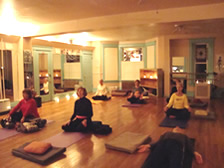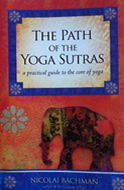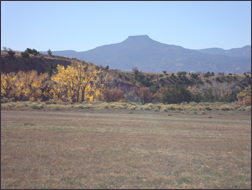 If you had asked me what yoga was after my first year of taking weekly classes, most likely I would have said it was doing special poses so you felt good, relaxed and stronger, and were healthier. Later, after I had started reading a little about yoga, I might have added something like, “finding your true self” (whatever that was).
If you had asked me what yoga was after my first year of taking weekly classes, most likely I would have said it was doing special poses so you felt good, relaxed and stronger, and were healthier. Later, after I had started reading a little about yoga, I might have added something like, “finding your true self” (whatever that was).
Even though my understanding was very limited at that time, I was getting the idea of yoga – yoga meant we were achieving something and yoga was how we got there.
In the beginning of the most important text on yoga, The Yoga Sutra, we learn that the state of yoga is what is to be achieved. While the translations vary slightly, they are all about the quieting of the movements (vrittis) of the mind (chitta) so we can see ourselves and all our relationships, choices, and actions with absolute clarity. But this is not easy.
The mind is in motion most of the time, moving from thought to thought. This is true for all of us. Our attention may be totally focused on our yoga practice or a project or an instrument we are playing. Then we smell coffee or bread baking, the dog starts barking, a childhood memory pops up, or an unpleasant conversation is remembered, and our mind deserts our yoga practice, the project, or the music. It almost seems as if the mind’s job is rumination as it falls into it so naturally, making us feel anxious and a bit crazed when thoughts start racing like squirrels in the attic. Then the state of yoga is far off in the distance.
Yet, Patanjali, compiler of the Yoga Sutra does not leave us with this difficult goal of yoga, an unruly mind, and no directions. He gives us a path. And the path is the activity of yoga.
In the first sutra of the second chapter of the Yoga Sutra, Patanjali offers the path of kriya yoga. The three components of kriya yoga help us to deal with mental and emotional afflictions keeping us stuck and suffering, as well as helping us to arrive at the state of yoga.
- The practice of postures and breathwork is often connected with the first component – tapas, or fire, heat, the goal of which is purification of our system to create positive change.
- The second component is svadhyaya or self-observation. We practice svadhyaya as we observe ourselves in postures, pranayama, meditation, in relationships. We study major texts, such as the Yoga Sutra, the Bible, or other important works, using them as mirrors to gain clarity about who we are.
- The third component of kriya yoga is isvara pranidhana, recognizing a power greater than ourselves to which we surrender the fruits of our actions.
Each of the practices comprising kriya yoga apply to the eight limbs of yoga, which Patanjali describes later in this chapter: ethical principles (yamas), attitudes toward ourselves (niyamas), postures (asana), breathing practices (pranayama), tuning out sensory input (pratyahara), concentration (dharana), meditation (dhyana), total and complete attention without sense of ego. This last is called samadhi, which is the state of yoga.
By applying tapas, svadhyaya, isvara pranidhana as we practice the tools given us in the eight limbs, we have a path. It is certainly not an easy or smooth path. But, it is a path, nevertheless, that with patient and consistent practice over time can quiet the movements of the mind so our vision becomes clear.
 I love designing salads. As paints are for an artist, the colors of lettuces and greens, carrots and beets, scallions and persimmons, olives and peppers, corn and peas, tomatoes and cucumbers, apples and oranges, strawberries, nuts, dates, raisins, and cranberries are my palette. I think about how their tastes and textures, as well as colors, create a beautiful, delicious, and healthful balance. But the salad is never complete until I have decided upon the perfect combination of vinegars and olive oils, enhanced with garlic, herbs, salt and pepper, to impart a glow to the greens.
I love designing salads. As paints are for an artist, the colors of lettuces and greens, carrots and beets, scallions and persimmons, olives and peppers, corn and peas, tomatoes and cucumbers, apples and oranges, strawberries, nuts, dates, raisins, and cranberries are my palette. I think about how their tastes and textures, as well as colors, create a beautiful, delicious, and healthful balance. But the salad is never complete until I have decided upon the perfect combination of vinegars and olive oils, enhanced with garlic, herbs, salt and pepper, to impart a glow to the greens.  My last five blogs focused on the klesas or afflictions. Knowing what they are, being able to recognize them in our lives, and having tools to deal with them are key to a sense of peace in our lives. My certainty about this comes not just from the teachings I have received, but also from my own experience.
My last five blogs focused on the klesas or afflictions. Knowing what they are, being able to recognize them in our lives, and having tools to deal with them are key to a sense of peace in our lives. My certainty about this comes not just from the teachings I have received, but also from my own experience.  My kids were 12 and 9 when we rented a rowboat at Burke Lake in Northern Virginia. The day was warm and sunny as I rowed us into the heart of the lake, the kids seated at opposite ends of the boat. My daughter sat sunning herself, and my son and I sat observing the sun on the water, the shoreline, and the other boats in the distance. I enjoyed the peacefulness of the day until my son started screaming and pointing at my legs and feet. Startled, I look down to see a snake slithering behind my legs on the seat where I sat.
My kids were 12 and 9 when we rented a rowboat at Burke Lake in Northern Virginia. The day was warm and sunny as I rowed us into the heart of the lake, the kids seated at opposite ends of the boat. My daughter sat sunning herself, and my son and I sat observing the sun on the water, the shoreline, and the other boats in the distance. I enjoyed the peacefulness of the day until my son started screaming and pointing at my legs and feet. Startled, I look down to see a snake slithering behind my legs on the seat where I sat. When I taught English Composition, students would come to me now and then to tell me they couldn’t write, or they hated writing. Their aversion to the course sometimes led them to avoid taking the class or dropping out or giving up, convinced they would fail no matter what. This decision had serious consequences. Without passing the required English classes, they could not receive an Associate Degree or transfer to a four year college.
When I taught English Composition, students would come to me now and then to tell me they couldn’t write, or they hated writing. Their aversion to the course sometimes led them to avoid taking the class or dropping out or giving up, convinced they would fail no matter what. This decision had serious consequences. Without passing the required English classes, they could not receive an Associate Degree or transfer to a four year college.  It is hard to give up a dream. But that is what my husband and I had to do. It started with our visits to Santa Fe, New Mexico. We enjoyed the landscape, the climate, the ambiance and everything about it. We decided to move there. It even became more of an obsession once our good friends moved there. We even had the house designed for the property we wanted, which would have made us neighbors of our friends. But it all fell through when we saw the cost and the reality that retirement was still a way off. Two more pieces of property became possibilities and both of those fell through for various reasons.
It is hard to give up a dream. But that is what my husband and I had to do. It started with our visits to Santa Fe, New Mexico. We enjoyed the landscape, the climate, the ambiance and everything about it. We decided to move there. It even became more of an obsession once our good friends moved there. We even had the house designed for the property we wanted, which would have made us neighbors of our friends. But it all fell through when we saw the cost and the reality that retirement was still a way off. Two more pieces of property became possibilities and both of those fell through for various reasons.